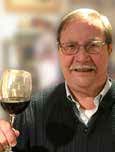By Ray Spaziani
Wine Talk

Ray Spaziani
In 1769, Franciscan missionary Father Junipero Serra planted the first California vineyard at Mission San “Diego de Alcala.” Serra continued to establish eight more missions and vineyards until his death in 1784 and has been called the father of California wine.
The grape variety he planted presumably descended from earlier Mexican plantings. It became known as the mission grape and dominated California wine production until about 1880. There are still to this day mission grapes planted in California but used primarily for distillation purposes and the production of California brandy. Wines made from mission grapes do not meet modern quality standards.
California’s first documented imported European wine vines were planted in Los Angeles in 1893 by Jean-Louis Vignes. In the 1850s and 60s, Agoston Harazsthy, a Hungarian soldier, merchant and promoter, made several trips to import cuttings from 165 of the greatest European vineyards to California. Some of this endeavor was at his personal expense and some through grants from the state. Overall, he introduced about 300 different grape varieties, although some were lost prior to testing due to difficulties in preserving and handling. On several of his trips to Europe, Harazsthy was promised reimbursement from the state of California for delivering the vine cuttings. But he was never paid.
Harazsthy is considered the founder of the California wine industry and contributed his enthusiasm and optimism for the future of wine along with considerable personal effort and risk. He founded Buena Vista Winery and promoted vine planting over much of northern California. He dug extensive caves for cellaring, promoted hillside planting, fostered the idea of non-irrigated vineyards and suggested redwood casks when oak supplies ran low. He was indeed the founder of the California wine industry.
In 1863, a species of Native American grapes was taken to botanical gardens in England. These cuttings carried a species of root louse called phylloxera, which attacks and feeds on the fine roots and leaves. European vines had no evolutionary protection. By 1865, it had spread to vineyards in Provence. Over the next 20 years, it inhabited and decimated nearly all the vineyards of Europe. Many methods were attempted to eradicate phylloxera, but all proved temporary and none economical.
Finally Thomas Munson, a horticulturist in Texas, suggested grafting the European vinifera vines onto American rootstock. There began a long, laborious process of grafting every wine vine in Europe over to American rootstocks. It was only in this manner that the European wine industry could be retrieved from extinction.
During the period when Europeans were dealing with phylloxera, the American wine industry was flourishing. California wine was exported throughout Europe and South America.
The destruction of the American wine industry would come from prohibition, which lasted from 1920 to 1933. Prohibition had been enacted in 1919, followed by the Volstead National Prohibition Act and the 18th Amendment to the Constitution in 1920 forbidding the manufacture, sale or transportation of intoxicating liquors.
Through a loophole allowing each home to “make 200 gallons of non-intoxicating cider and fruit juice per year,” thousands of otherwise law-abiding citizens became home winemakers and bootleggers. Prices for fresh grapes shot up because of the increased demand and a railroad shortage of refrigerated freight cars in which to ship them.
Several states stayed dry after the repeal of prohibition. Other states got into the liquor business by running state package stores. Other states granted licenses. The only group of wines that sold well were the fortified dessert wines. Taxed at a lower rate than distilled spirits, but with 20 percent alcohol, this group made the cheapest intoxicant available. It wasn’t until 1968 that table wines overtook fortified wines, regaining the status of most popular wine category.
In 1920 there were more than 2,500 commercial wineries in the US. Less than 100 survived as winemaking operations by 1933. Prohibition distorted the role of alcohol in American life and ruined a fledgling world-class wine industry, which took decades to overcome.
Some California winemakers began to produce quality wines but still had difficulty marketing them. Frank Schoonmaker, a prominent journalist and wine writer in the 1950s and 60s introduced the idea of labeling wines using varietal (Pinot Noir, Chardonnay, Riesling) rather than generic names borrowed from famous European regions.(Burgundy, Chablis, Rhine). Robert Mondavi was one of the first to label the majority of his wines by varietal names and was tireless in promoting the practice.
By the late 1960s and early 1970s, the quality of some vintners’ wines was outstanding. But few took notice. On May 24, 1976, a blind tasting was held in Paris with a panel made up exclusively of French wine experts. After comparing California Chardonnays with the very best French chards, three of the top four were Californian. Every one of the nine judges ranked Chateau Montelena the highest. Chalone Vineyard came in third and Spring Mountain ranked fourth. When reds were evaluated, Stag’s Leap Wine Cellars was ranked number one, above Chateau Mouton-Rothschild, Chateau Montrose, Chateau Hout-Brion, and Chateau Leoville Las Cases. America had arrived.
Ray Spaziani is the chapter director of the New Haven chapter of the American Wine Society. He is on the tasting panels of Winemaker Magazine and Amate del Vino and is a certified wine educator and award-winning home winemaker. Email Ray with your wine questions or activities at realestatepro1000@gmail.com.